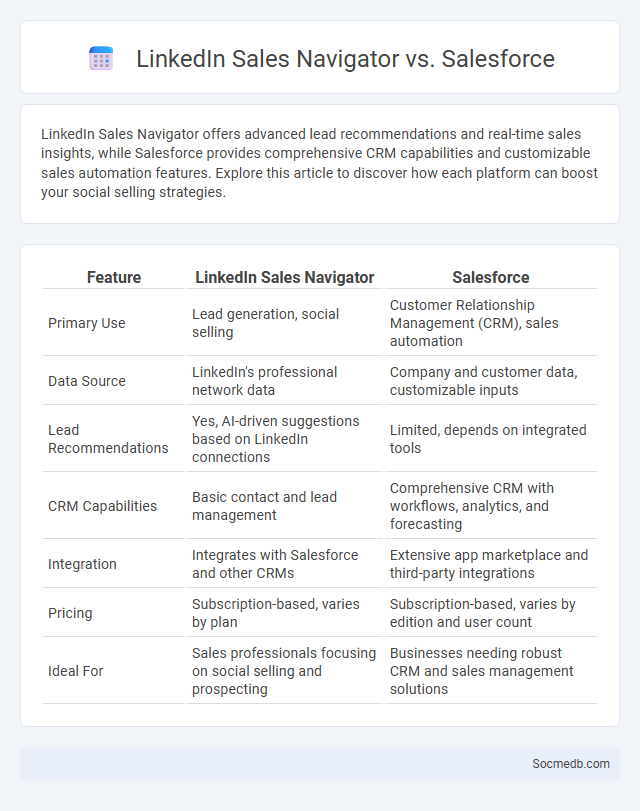
Photo illustration: LinkedIn Sales Navigator vs Salesforce
LinkedIn Sales Navigator offers advanced lead recommendations and real-time sales insights, while Salesforce provides comprehensive CRM capabilities and customizable sales automation features. Explore this article to discover how each platform can boost your social selling strategies.
Table of Comparison
| Feature | LinkedIn Sales Navigator | Salesforce |
|---|---|---|
| Primary Use | Lead generation, social selling | Customer Relationship Management (CRM), sales automation |
| Data Source | LinkedIn's professional network data | Company and customer data, customizable inputs |
| Lead Recommendations | Yes, AI-driven suggestions based on LinkedIn connections | Limited, depends on integrated tools |
| CRM Capabilities | Basic contact and lead management | Comprehensive CRM with workflows, analytics, and forecasting |
| Integration | Integrates with Salesforce and other CRMs | Extensive app marketplace and third-party integrations |
| Pricing | Subscription-based, varies by plan | Subscription-based, varies by edition and user count |
| Ideal For | Sales professionals focusing on social selling and prospecting | Businesses needing robust CRM and sales management solutions |
LinkedIn Sales Navigator vs Salesforce: Key Differences
LinkedIn Sales Navigator offers advanced lead recommendation algorithms and deeper integration with LinkedIn's professional network, enabling more precise prospecting and relationship-building for B2B sales teams. Salesforce excels in comprehensive CRM capabilities, providing robust pipeline management, customizable workflows, and extensive analytics for tracking overall sales performance. The primary difference lies in LinkedIn Sales Navigator's focus on social selling and prospect discovery, while Salesforce delivers end-to-end sales process automation and data management.
Social Selling Explained: The Modern Sales Approach
Social selling leverages social media platforms like LinkedIn, Twitter, and Instagram to build relationships and engage potential customers directly through personalized content and interactions. This modern sales approach integrates social listening, targeted outreach, and valuable content sharing to nurture leads and accelerate the buyer's journey. Companies using social selling techniques report increased conversion rates and shorter sales cycles due to enhanced trust and credibility.
Feature Comparison: LinkedIn Sales Navigator vs Salesforce
LinkedIn Sales Navigator offers advanced lead recommendations, real-time updates, and deep integration with LinkedIn's vast professional network, making it ideal for targeted B2B engagement. Salesforce excels with comprehensive CRM capabilities, customizable workflows, and robust analytics that streamline sales pipeline management. Your choice depends on whether you prioritize LinkedIn's rich contact insights or Salesforce's all-in-one sales automation platform.
Integration Capabilities: LinkedIn, Salesforce, and Social Selling Tools
Social media platforms offer robust integration capabilities with tools like LinkedIn, Salesforce, and various social selling applications, enhancing your ability to streamline customer relationship management and sales processes. These integrations enable seamless data synchronization, lead generation, and advanced analytics, empowering you to leverage social insights for targeted marketing strategies. Leveraging these tools effectively can significantly improve your sales pipeline and customer engagement on social platforms.
Lead Generation: Which Platform Delivers Better Results?
Facebook's robust targeting options and vast user base make it a top choice for lead generation, offering advanced tools like lead ads that seamlessly capture user information. LinkedIn excels in B2B lead generation by connecting you with professionals and decision-makers through precise industry and job title filters. Choosing the right platform depends on your target audience, with Facebook yielding better results for B2C markets and LinkedIn driving higher-quality leads in professional sectors.
User Experience & Interface: A Side-by-Side Analysis
Social media platforms prioritize intuitive user experience (UX) and responsive user interfaces (UI) to enhance engagement and retention. Features like personalized content feeds, simplified navigation menus, and quick-loading times contribute to seamless user interactions. Comparative analysis reveals that platforms with adaptive design and interactive elements consistently outperform in user satisfaction metrics.
Pricing and ROI: Evaluating Sales Navigator, Salesforce, and Social Selling Investments
Sales Navigator pricing varies by plan, starting at approximately $79.99 per user per month, offering advanced lead recommendations and CRM integration that boost sales efficiency and ROI. Salesforce pricing depends on the chosen edition, with Sales Cloud plans ranging from $25 to $300 per user per month, delivering comprehensive sales automation and analytics to improve pipeline management and revenue growth. Investing in social selling tools requires measuring ROI through metrics like lead conversion rates, deal size increase, and sales cycle reduction to ensure the chosen platform aligns with business goals and maximizes return.
Success Stories: Real-World Use Cases
Social media platforms have transformed marketing strategies, enabling brands to engage directly with their audiences through targeted campaigns that boost brand awareness and drive sales. Influencers and small businesses leverage user-generated content and viral trends to create authentic connections, resulting in measurable growth and revenue increases. Your business can harness these success stories to implement data-driven social media tactics that generate tangible results and foster loyal customer communities.
Which Solution Fits Your Sales Strategy Best?
Choosing the right social media solution hinges on aligning platform features with your sales strategy goals. For B2B sales, LinkedIn's targeted advertising and lead generation tools provide precise audience reach and professional engagement. E-commerce brands benefit from Instagram and Facebook Shops, leveraging visual content and seamless purchase integration to boost conversions.
Future Trends: The Evolution of Social Selling Platforms
Social selling platforms are rapidly evolving with advancements in AI-driven personalization, immersive AR experiences, and sophisticated data analytics to boost customer engagement and conversion rates. Your business can leverage these innovations to create hyper-targeted marketing strategies and seamless shopping experiences across social networks. Embracing these future trends ensures competitive advantage and maximizes ROI in the dynamic digital marketplace.
 socmedb.com
socmedb.com